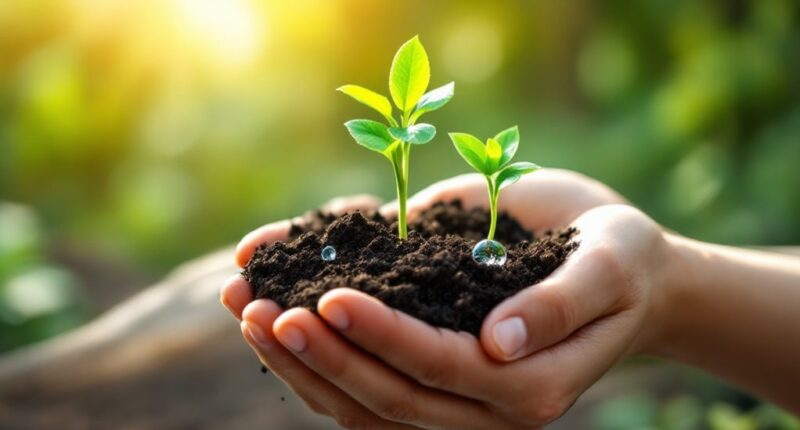The science of sustainability integrates three essential pillars: environmental, social, and economic dimensions. Environmental sustainability forms the foundation, focusing on ecological balance, biodiversity protection, and resource conservation. Social aspects guarantee equity across populations, while economic considerations demonstrate that green practices can be profitable. Unlike mere corporate jargon, sustainability represents a scientific approach to maintaining planetary health through measurable metrics and balanced decision-making. The journey toward true sustainability requires understanding these principles in their complex, interconnected entirety.

Foundations and frameworks—these are the building blocks upon which sustainability stands in our increasingly interconnected world. The concept of sustainability isn’t just a trendy buzzword thrown around at corporate retreats; it’s a scientific approach to guaranteeing our planet remains habitable for generations to come.
Like a three-legged stool that topples if any support is missing, sustainability rests on three essential pillars: environmental, social, and economic considerations that must work in harmony.
Environmental sustainability serves as the bedrock of the entire concept. It’s nature’s way of saying, “I’ve got finite resources, so let’s use them wisely.” This principle focuses on maintaining ecological balance, reducing carbon footprints, and protecting biodiversity—because what good is economic prosperity if we’re left with unbreathable air and undrinkable water?
Think of it as living within our planetary means rather than maxing out Earth’s credit card.
The social dimension recognizes that humans aren’t simply economic units but complex beings requiring equity, health, and education. Social sustainability guarantees that while we’re busy saving the planet, we’re not leaving vulnerable populations behind.
After all, a “sustainable future” that benefits only a privileged few isn’t particularly sustainable.
Economic sustainability completes our tripod of principles, demonstrating that environmental protection needn’t come at the expense of livelihoods. It promotes circular economies where today’s products become tomorrow’s resources, not tomorrow’s waste. True sustainability emerges only when these three pillars are given equal consideration in decision-making processes.
Green technologies aren’t just good for the environment—they’re increasingly good for the bottom line too.
The precautionary principle guides responsible action by encouraging preventive measures in the face of environmental uncertainty, even before complete scientific consensus is established.
Businesses worldwide are integrating these principles into their core strategies, guided by the United Nations’ 17 Sustainable Development Goals—a global to-do list for humanity to achieve by 2030.
Companies are increasingly using ESG metrics to demonstrate their commitment to sustainability and attract socially-conscious investors.
From zero hunger to climate action, these goals provide a roadmap for nations and corporations alike.
Measuring sustainability isn’t just counting trees or calculating carbon offsets; it’s a thorough assessment using key performance indicators that track our progress toward a more balanced relationship with our planet—one where prosperity doesn’t come at the expense of our future.
Frequently Asked Questions
How Do Individual Actions Impact Global Sustainability Efforts?
Individual actions create ripple effects that impact global sustainability.
While personal choices like reducing meat consumption or using public transportation decrease one’s carbon footprint, their greatest power lies in collective influence. These behaviors can create social contagion, shape market trends, and catalyze systemic change.
However, critics argue that focusing solely on individual responsibility distracts from addressing corporate emissions and structural barriers, suggesting effective sustainability requires both personal and institutional transformation working in tandem.
Can Economic Growth Coexist With Environmental Sustainability?
Evidence suggests economic growth and environmental sustainability can indeed coexist. The concept of “green growth” demonstrates how countries can increase GDP while reducing emissions through renewable energy adoption, technological efficiency, and circular economy models.
Some high-income nations are already showing promising signs of decoupling growth from environmental degradation.
However, significant challenges remain, including population pressures, consumption patterns in wealthy countries, and the unique development needs of emerging economies.
What Technologies Show the Most Promise for Sustainable Development?
Several technologies show exceptional promise for sustainable development.
Renewable energy technologies, particularly solar photovoltaics and offshore wind, continue to improve in efficiency while decreasing in cost.
AI-powered systems optimize resource usage across sectors, from energy grid management to precision agriculture.
Energy storage solutions, including advanced batteries and smart grids, address intermittency challenges of renewables.
Meanwhile, sustainable materials and circular economy innovations help reduce waste and resource consumption, creating systems that mimic nature’s efficiency in cycling materials.
How Does Biodiversity Loss Affect Sustainable Ecosystems?
Biodiversity loss undermines ecosystem sustainability by disrupting natural processes that keep systems functional. When species disappear, ecosystem productivity declines as nutrient cycling weakens and food webs unravel.
The ripple effects extend to economic losses ($10 trillion annually) and human health risks, including increased disease transmission. Like removing rivets from an airplane, each species loss weakens ecosystem resilience against environmental disturbances, making them less adaptable to challenges like climate change and invasive species.
What Role Do Developing Countries Play in Global Sustainability?
Developing countries play a complex dual role in global sustainability. They face disproportionate impacts from climate change while their emissions grow rapidly. Countries like Kenya lose approximately 3% of GDP annually to climate effects, yet agricultural expansion increases their carbon footprint.
Despite limited resources and infrastructure for environmental initiatives, many are pioneering sustainable solutions. Botswana’s 15% emissions reduction target and Malaysia’s sustainable palm oil certification demonstrate how developing nations are becoming essential partners in addressing global environmental challenges.









